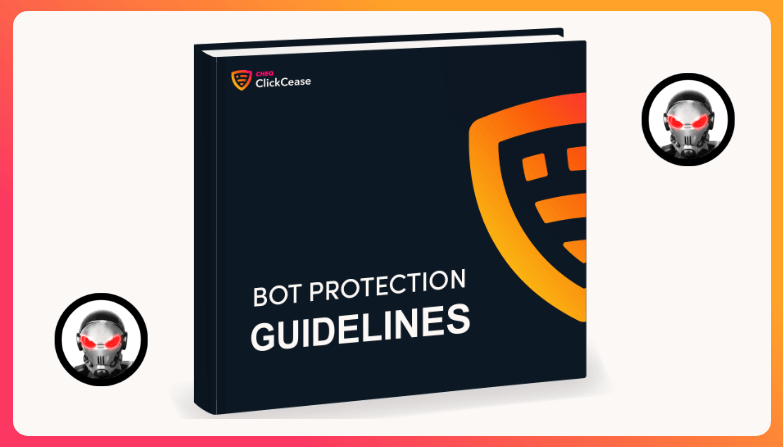Bots are everywhere. Some bots are your friend. Many others aren’t.
When it comes to online safety, especially as a website owner, understanding bot protection and bot management has never been more important.
Are bots clicking your ads, or are bots stealing your content? Perhaps bots are pretending to be your customers and ordering your products using stolen credit cards?
Yup, there is a lot to bear in mind.
Here at ClickCease we spend a lot of time looking at bot traffic and bot behaviour online. So, we’ve put together this guide about bot protection to help you make sense of what is going on.
What are bots?
The term bot is short for robot, and refers to a scripted program used online for a variety of purposes. And because it is a scripted program, a bot can be used to undertake various tasks from simple to complex.
For example, a simple bot can be used to post a standard response in comment forms or on social media profiles. This is a form of a spam bot, which you have probably experienced before.
A more complex form of internet bot is the chat bot. These bots are used to provide customer service support and are integrated into a website by the website owner. Chat bots can then interact with customers using a specific model of preset responses.
But they can also collect extra information from a database to provide specific support, or can also switch to human based customer support if needed.
However there are also malicious bots, which are unfortunately widespread. These are bots used to perform all manner of fraudulent activities such as stealing data, performing hacking activity such as account takeovers, and stealing your money in a variety of ways.
A brief history of bots
Bots have actually been around since before the age of the internet. In fact, bots and AI have been used since the 1950’s.
Alan Turing, widely seen as the grandfather of AI developed a test based on a game, the Imitation Game. The theory was to have two unseen participants convince a person that they were something that they’re not. In the case of the Turing Test, the two hidden participants were meant to persuade a human that they were also human. Of course, one of the participants is a computer.
The Turing Test remains a benchmark of whether a machine can either think or fool a human.
In 1954 we saw the first software designed to play games. First of all, a team simulated various hundreds of hands of Blackjack to work out how to best play against them. This then set the benchmark for game playing bots which make decisions based on provided data.
In the 1960’s, a bot named ELIZA was developed by Professor Joseph Weizenbaum at MIT. ELIZA was meant to act like a psychotherapist by offering questions to typed responses, in much the same way as a therapist might ask similar probing questions.
You can still talk to ELIZA today, which makes for a few minutes of amusement.
And if you think that viruses and trojans don’t appear until the internet era, you’re in for a surprise. Creeper, the first self-replicating software program, first appears in 1971. Originally designed as a test to see if software could spread itself, Creeper would spread itself over the ARPANET, an early version of the internet.
And although Creeper had no malicious intent, it still served as the first example of automated and self-propagating software.

The internet era
Fast forward to the 1980’s and the birth of the modern internet. In 1983, the computers started talking to each other over phone cables, and by the early 90’s the world wide web became accessible to home users.
Some early internet bots were used to automate responses on chat networks, such as the IRC (Internet Relay Chat). And with early search engines such as AOL and Excite came web crawlers, who collected data from across the fledgling internet to deliver search results in real time.
The 90’s also saw the first spam bots, with the Usenet spam bot often cited as the first example. And, in case you hadn’t noticed, spam bots are still quite popular today.
The rise of fraud bots
It didn’t take long for malicious bots to materialize. 2000 saw the arrival of GTbot, or Global Threat bot, one of the first known instances of a botnet used for cybercrimes such as denial of service attacks.
As Google Adwords made its first appearance in 2000, publishers were quick to realize that they could inflate their ad payout by repeatedly clicking ads on their sites. However it’s not until Clickbot A was uncovered in 2006 that it became obvious that bots and botnets were being used to automate these fraud clicks.
Fast forward to today and it’s estimated that over half of all internet traffic is automated. From web crawlers collecting useful data and information, to malicious botnets carrying out various forms of fraud – today anyone online needs to be aware of the possibility of bot based fraud.
And if you’re running a website, bot protection is a security necessity.
What can bots be used for?
Bots are often used to perform online tasks which might take a human a long time. This can include:
- Crawling the internet to provide search information (Google search results for example)
- Analyzing traffic data for research tools (e.g: Ahrefs, SEMRush, and other data tools)
- Collecting personal information such as email addresses (data scraping)
- Verifying transactions or other data
- Delivering fresh content such as news reports or social media posts
- Interacting with customers and providing customer service via chatbots
- Sending automated responses on social media platforms or websites
But of course, there is plenty of malicious bot activity that can occur too. In fact most cyber crimes and data breaches are performed using bot automation.
If you manage a website or a business that provides a service online, stores data on the internet or uses digital advertising then you also need to understand the potential threats from bot attacks.

The main bot attack threats
Bot powered attacks on websites can come in various forms, and some might even seem quite innocuous such as spam.
But if a bot can access your website, you can experience any or all of the effects of unwanted bot traffic. This includes:
Database access
Bots can access online databases using credential stuffing. This is where bots are used to attempt to crack accounts using commonly used passwords – which is why you should always use complex and unique passwords.
Once a bot has access to an online database it can collect information about your customers personal information including addresses, payment information and other sensitive details.
Payment card fraud
With hundreds or thousands of stolen payment details to process, it’s quicker for a bot to try multiple cards on your site than it is for a human to input the details. This results in a barrage of fraudulent transactions, chargebacks and even lost inventory. Of course your site needs to have a checkout function in order for this to work.
Read more about payment fraud here.
Content scraping and website spoofing
Although content scraping might seem like a relatively insignificant action, it can result in bigger problems. For example, by copying a website, aka spoofing, fraudsters can impersonate your business and use your branding for phishing, payment card harvesting, social engineering and other fraudulent activities.
Read more about content scraping here.
Traffic based bot attacks
Bot traffic can be used to overload bandwidth and take websites offline – a practice known as Distributed denial of service attacks (DDoS). Bot traffic can also be used to inflate the viewing metrics and engagement on PPC ads, talking of which…
Ad fraud and click fraud
If you pay per click or per impression on your ads, about 1 in 4 of those are not genuine humans. Yup, unwanted bot traffic can click or watch your ads putting you out of pocket in your marketing. Fun fact: ad fraud and click fraud are more lucrative than credit card fraud, making off with over $41 billion in 2021 – and rising…
Find out more in our complete guide to click fraud.
Spreading viruses and malware
Although the most common way of viruses spreading is through clicking downloads or suspicious links, bots can also spread malware by embedding code into websites or apps. Using attacks such as SQL injection means malware elements can be added to your app or website if it isn’t properly protected.
Find out more about malware injection bots here.
Fake social media profiles
Bots are often used to generate fake followers and engagement on social media platforms. Although this tends not to be malicious, these bots can have a negative impact on your marketing efforts. Fake ad impressions, or ad fraud, on social media is a big concern for both paid advertising and influencer marketers.
Spam
Perhaps the most obvious and annoying form of unwanted bot traffic is from spam. Spam bots fill up your comments boxes, enquiries forms and email inbox with a seemingly endless barrage of garbage. And as if simply annoying you wasn’t enough, spam bots can even perform spam injection – a form of black hat SEO where bots add low quality links and content to your site without your knowledge.
Read more about spam injection in our blog.

How can bot attacks be prevented?
Preventing bots from attacking your website requires software designed to catch this malicious traffic. Although many website platforms such as WordPress or Shopify do offer software to catch and prevent bots, increasingly the world of malicious bots is becoming more sophisticated.
Keeping bad bot traffic off your website needs specialist tools. And this is especially true if you process payments on your website, or have a customer login.
But any website can fall victim to DDoS attacks or even malware injection. And these automated attacks can result in lost business, damage to your reputation and negative publicity, not to mention the cost and hassle to restore the site.
Although there is a lot of choice for bot protection security, ClickCease offers an all-in-one bot mitigation solution.
ClickCease has specialized in click fraud prevention, using advanced machine learning algorithms to spot and block fake traffic on PPC ads.
And with our new Bot Zapping tool, ClickCease now offers a full bot protection solution designed to prevent fraudulent activity from account takeovers to spam injection.
Stop unwanted bots on your website, protect your marketing spend and make sure only the good bots get through. Try ClickCease for FREE for 7 days and see for yourself how much of a difference it makes.
